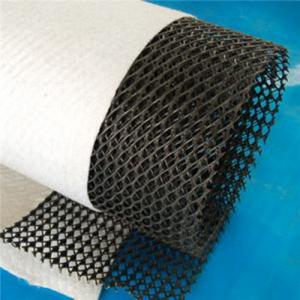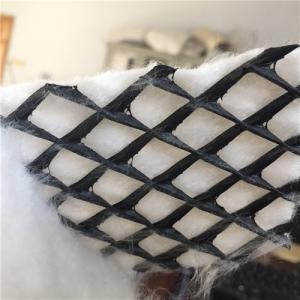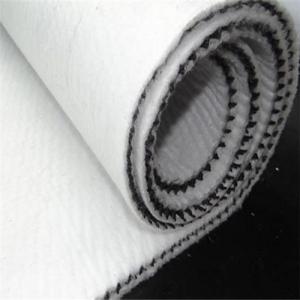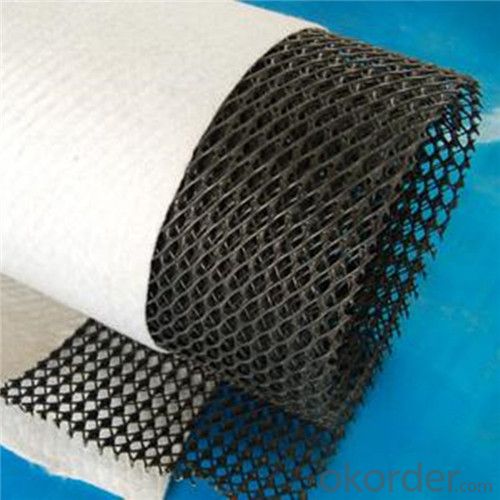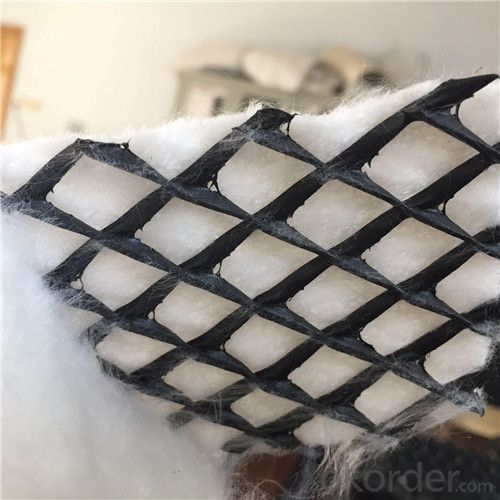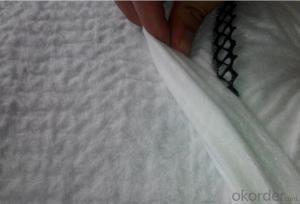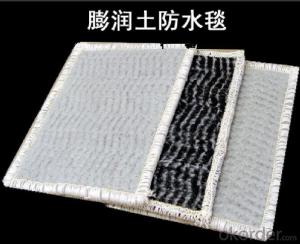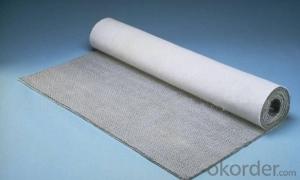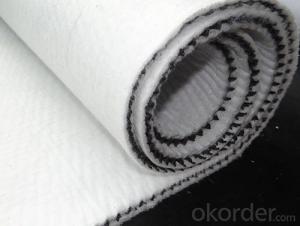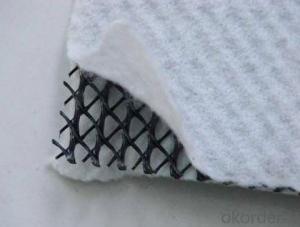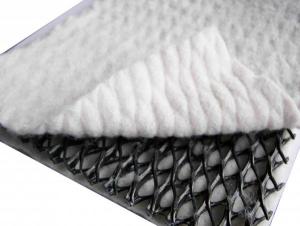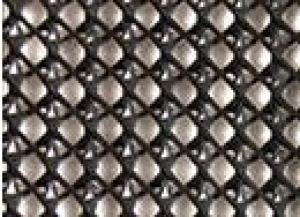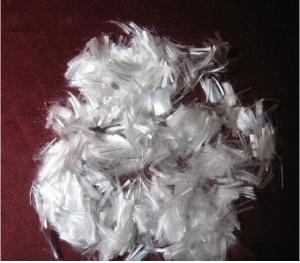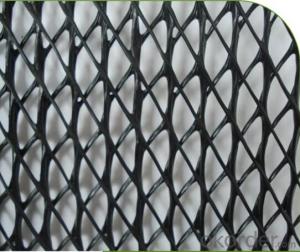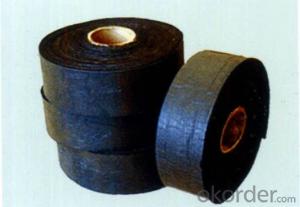Three-Dimensional Composite Drainage by Geonet and Geotextile
- Loading Port:
- Qingdao
- Payment Terms:
- TT or LC
- Min Order Qty:
- 1000 m²
- Supply Capability:
- 10000 m²/month
OKorder Service Pledge
OKorder Financial Service
You Might Also Like
Composite Geonet Description:
Composite geonet is a new type drainage material. It has three layers: three-dimensional geonet and nonwoven geotextile on both sides.
The material of geonet is HDPE, and the material of geotextile can be needle punched PET/PP nonwoven geotextile, and thermalbonded continuous filament nonwoven geotextile.
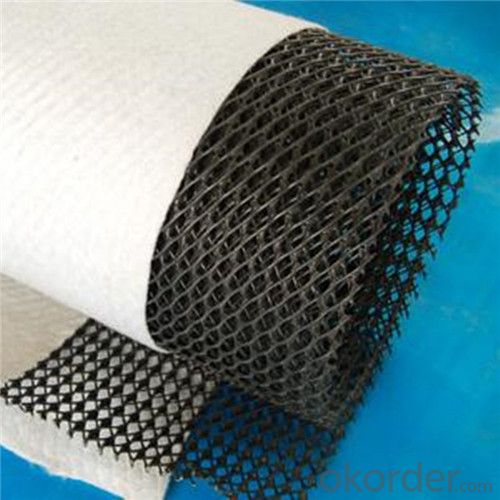
Composite Geonet Specification:
Thickness of geonet: 5mm to 8mm
Weight of geotextile: 200g/m2, as request
Width: 2m-4m
Length: as request
Composite Geonet Property:
Tri-dimension composite geonet has the property of geotextile (filtration function) and geonet (drainage and protection function), it can provide a function system: filtration-drainage-protection. The core of net with its unique tri-dimension structure can bear high
compression load in construction and remain certain thickness, provide good water conductivity.
Composite Geonet Application:
Landfill drainage, roadbed and road drainage, railway drainage, tunnel drainage, underground structure drainage, the retaining back wall
drainage, gardens and sports grounds drainage.
Packaing
Our packing is strong enough to withstand bumping and rough handling under normal condition.
We can accept add customer's logo on the package.
Our Service
1. OEM Manufacturing welcome.
2. Free Sample to see our quality.
3. We will reply you for your inquiry in 24 hours.
4. After sending, we will track the products for you once every two days, until you get the products. When you got the goods, test them, and give me a feedback.If you have any questions about the problem, contact with us, we will offer the solve way for you.
- Q: Why the ancient Chinese architecture to civil materials, while the use of stone in Europe it?
- Different ethnic, yellow constitution is relatively weak, and like warm, will use the structure! So much more wood; Western people physically strong, and advocating power, and stone can give people strong and more majestic feeling!
- Q: What are the different applications of geogrids in road and railway construction?
- Geogrids have various applications in road and railway construction. They are commonly used for soil stabilization, reinforcement, and erosion control. Geogrids help to distribute loads, increase the strength and stability of the ground, and prevent the movement of soil particles. In road construction, geogrids are used for base reinforcement, subgrade stabilization, and pavement overlay. They can also be utilized in railway construction for ballast reinforcement, track bed stabilization, and slope protection. Overall, geogrids play a crucial role in enhancing the durability, performance, and longevity of roads and railways.
- Q: How do geocells provide erosion control on steep slopes?
- Geocells provide erosion control on steep slopes by confining and stabilizing the soil, preventing it from being washed away by water runoff. The interconnected cells create a structural matrix that reinforces the soil, reducing the velocity of water flow and minimizing erosion. Additionally, the geocells promote vegetation growth by retaining moisture and nutrients, further enhancing erosion control on steep slopes.
- Q: What are the different installation techniques for earthwork products?
- The different installation techniques for earthwork products vary depending on the specific product being used. Some common techniques include excavation and grading, compaction, backfilling, and erosion control measures. Each technique is tailored to the specific requirements and characteristics of the earthwork product and the site conditions. It is important to follow manufacturer instructions and consult with experts to ensure proper installation and long-term performance of the earthwork products.
- Q: What are the different types of geosynthetic tubes used in earthwork?
- There are several types of geosynthetic tubes used in earthwork, including geotextile tubes, geogrid tubes, and geocell tubes. These tubes are made of synthetic materials and are used for various purposes such as erosion control, soil stabilization, and retaining walls. Geotextile tubes are commonly used for dewatering and shoreline protection, while geogrid tubes are used for slope stabilization and reinforcement. Geocell tubes, on the other hand, are used for load support and erosion control in areas with high traffic or heavy machinery. Overall, each type of geosynthetic tube serves a specific purpose and can greatly enhance the performance and durability of earthwork projects.
- Q: What are the different surface finishes available for earthwork products?
- The different surface finishes available for earthwork products include smooth finishes, textured finishes, stamped finishes, exposed aggregate finishes, and decorative finishes.
- Q: Can earthwork products be used for constructing boat ramps?
- Yes, earthwork products such as soil, gravel, and rocks can be used for constructing boat ramps. These materials can be used to build the base and slope of the ramp, providing stability and traction for boats during launching and loading. Additionally, earthwork products can be shaped and compacted to create a smooth and durable surface for boat ramp construction.
- Q: How can geonets be used in stormwater filtration systems?
- Geonets can be used in stormwater filtration systems as a support structure for various filter media. They provide a stable framework that helps retain and distribute the filter media, enhancing the system's efficiency in trapping sediment, pollutants, and debris from stormwater runoff.
- Q: Are earthwork products durable?
- Yes, earthwork products are generally durable due to their robust construction and use of high-quality materials. They are designed to withstand various weather conditions, heavy loads, and frequent use, ensuring long-lasting performance and reliability. Additionally, proper maintenance and regular inspections can further extend their durability and lifespan.
- Q: The Importance of Civil Engineering Materials in Engineering Construction
- Material to determine the process, according to the material to determine the construction methods, materials on the project cost, perception, quality requirements, engage in earthquake design, fire design, energy saving design and so have a very important impact
Send your message to us
Three-Dimensional Composite Drainage by Geonet and Geotextile
- Loading Port:
- Qingdao
- Payment Terms:
- TT or LC
- Min Order Qty:
- 1000 m²
- Supply Capability:
- 10000 m²/month
OKorder Service Pledge
OKorder Financial Service
Similar products
Hot products
Hot Searches
